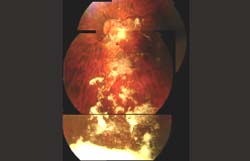40

Implications of the Off-Label Use of Medications in Vitreoretinal Surgery
Chirag C. Patel  Scott C. N. Oliver
Scott C. N. Oliver  Naresh Mandava
Naresh Mandava  Jeffrey L. Olson
Jeffrey L. Olson  Hugo Quiroz-Mercado
Hugo Quiroz-Mercado
INTRODUCTION
In the United States, the “off-label” use of a medication means that it is being used for an indication that has not been approved by the Food and Drug Administration (FDA). The off-label use of medications is much more common than one may think. An estimated 20% of all medications prescribed in the United States are prescribed off-label (1). In certain specialties such as cardiology, psychiatry, and pediatrics, the rate of off-label drug use is even higher. Off-label prescribing is most commonly done with older medications that have found new uses but have not been subjected to the formal and often costly clinical trials required by the FDA to officially approve a drug for new indications. However, there is usually evidence in the medical literature to support and justify the off-label use.
The issue of off-label drug use has become more prominent recently in vitreoretinal surgery with the advent of vascular endothelial growth factor antagonists (VEGF-A), or anti- VEGF agents. Bevacizumab (Avastin, Genentech, south San Francisco, CA) was the first clinically available angiogenesis inhibitor in the United States. It was initially approved in 2004 for the treatment of metastatic colon and nonsmall cell lung cancer (2). In 2005, bevacizumab was first injected into a human eye. Two case reports resulted, one showing benefit in a patient with choroidal neovascularization from age-related macular degeneration (AMD) (3) and another showing improvement in macular edema in a patient with a central retinal vein occlusion (4). Despite the subsequent plethora of studies demonstrating safety and efficacy in treating a variety of ophthalmic conditions with intravitreal injections of bevacizumab, there is still no prospective, randomized, long-term, adequately powered safety and efficacy information for intravitreal bevacizumab. Also absent are rigorous dose escalation or dose frequency studies. There is, therefore, no scientifically determined optimal dose or dosing frequency.
In July 2006, ranibizumab (Lucentis, Genentech, south San Francisco, CA) was approved by the FDA for treatment of AMD by intravitreal injection. Ranibizumab is a Fab molecule derived from its parent molecule bevacizumab and works in a similar fashion by binding to VEGF-A (5). Despite FDA approval, many vitreoretinal surgeons have resisted using ranibizumab because bevacizumab is significantly cheaper. In the United States, a single dose of ranibizumab can cost about $2000 compared to $40 for a single dose of bevacizumab (6). There is also no compelling evidence that one works any better than the other. A small prospective study supports this conclusion (6), and there is currently an ongoing head to head clinical trial comparing the two drugs (7). Unless evidence surfaces that ranibizumab is a more effective drug, or until a more effective drug is developed, Avastin will likely continue to be used as a popular off-label drug by the vitreoretinal surgeon.
OFF-LABEL DRUG USE IN VITREORETINAL SURGERY
Stay updated, free articles. Join our Telegram channel

Full access? Get Clinical Tree


